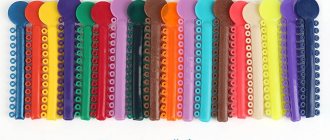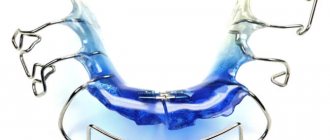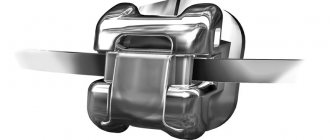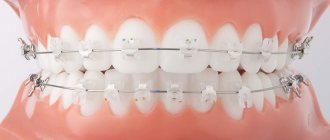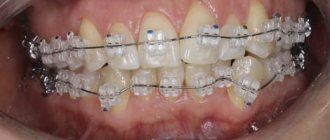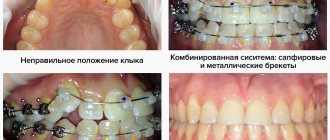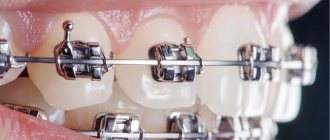In orthodontics, plates or braces are most often used to correct bite pathologies. These two types of structures successfully cope with the task assigned to them, but they are very different from each other in type, purpose, price, etc. Therefore, many patients are concerned with the question, which is better to use for braces or plates to correct the bite? Only through comparison will each patient be able to decide on the choice of the system that is suitable for him.
What is the difference between the design of plates and braces?
Plates and braces are equally often used in pediatric orthodontics to correct bites and correct dentition.
They have significant design differences:
- Plate structures are a removable device for the correction of teeth occlusion disorders. Designed to correct minor malocclusions. They align separately located units well with each other. The devices cannot apply significant pressure to the jaw and teeth. Systems can only hold units and prevent them from bending. They can activate or inhibit jaw growth. These designs are worn for several hours during the day. It is possible to remove them from the oral cavity and install them yourself. They are removed during meals for hygiene purposes.
- Braces are a reliable orthodontic system and are non-removable structures. It cannot be removed by the patient himself. She copes with the correction of the most complex dental defects. The process of straightening teeth with systems is quite lengthy. It lasts up to several years, so a certain psychological attitude is required from the patient. The design consists of locks that are tightly attached to the teeth using special glue. They are fastened with a metal arch, which exerts significant pressure on the dental units and alveolar processes.
Only the orthodontist decides which design to choose for the patient to correct closure anomalies.
Plate after braces: what is it for, how long to wear
After the main treatment and removal of braces, a period of consolidation of the results begins. A plate on the teeth after braces is a type of removable retainer. The result of long-term treatment is pleasing, but there is still mobility of the teeth, and the likelihood that a few will “want” to return to their previous position remains. The plate is designed to secure the position of the units, which is given by braces.
Which variety should I use after braces? How long should I wear it? Is it possible (and how often) to shoot? These issues should be discussed with your treating orthodontist.
There can be no definite answer - each organism is individual, various defects are corrected. On average, the retention period lasts one and a half times longer than treatment. But it is much easier to tolerate. In the first week or two, you may feel discomfort from wearing the plate after braces, but it is only temporary. Your doctor will also tell you how many hours to wear it and whether to remove the device while eating. Sometimes it is enough to wear the device at night; for other anomalies, wearing it 22 hours a day is required. Today, the role of plates has been quite confidently taken over by retention guards and aligners.
Sign up for a consultation and we will consider your situation in detail and choose the optimal solution. Each clinical case is unique for me, as a specialist with more than 20 years of experience in correcting occlusion. Therefore, I prefer to supervise the treatment process from the first visit until the patient’s complete recovery. You can always ask a question, discuss doubts.
Differences in mechanism of action
Correction devices differ in their mechanism of action. Plate designs have one or more screws. They allow the growing jaw to expand, making room for permanent teeth. Metal arches correspond to the correct position of units in the dentition. The device cannot have a significant effect on the jaw. She cannot move dental units over a significant distance. It is used when there is no need to move it over long distances. It copes well with tilting and turning individual units. It is also used in young children to prevent malocclusion or to change the width of the growing palate.
Appliances for permanent wear have a wider range of possibilities for correcting malocclusion and dentition defects. The systems are able to place the tooth in the required place by pulling it out of the alveolus. Braces can immerse it deeper into the jaw, tilt it in the required direction, or rotate it relative to its axis. Unlike removable appliances, they are capable of correcting serious disorders of the dental system, and not just preventing them.
How to determine which is better
Plates are more suitable for children aged 5–7 years, whose temporary bite is replaced by a permanent one. Even kids can take care of retainers; they are easy to remove for meals and clean with a regular brush. The plates are inexpensive, but they do not correct serious deviations.
When wearing braces, which place constant pressure on the row:
- adaptation occurs quickly;
- the teeth will mix in the right direction;
- birth defects are eliminated;
- abnormal bite is corrected.
The answer to the question of what is better: metal braces, another type of braces or a plate depends only on the real needs of the patient.
You should consult your dentist to determine the right orthodontic system for you. The doctor's consultation
Differences in indications for installation
Indications for the installation of both devices are violation of jaw closure, curvature of the dentition, displacement of individual dental units. However, they may differ in a number of parameters.
Indications for installing permanent structures:
- single defects of dental units;
- several crooked adjacent incisors;
- large gaps;
- anterior displacement of the incisors;
- various types of closure defects;
- impaired diction associated with malocclusion;
- deformations of the facial skeleton;
- crowding.
Indications for the installation of systems are severe pathologies of the dentofacial system, including in a fully formed jaw.
Indications for correction of anomalies with plates are as follows:
- beginning movement of teeth in the wrong direction;
- high probability of displacement of dental units;
- signs of initial jaw deformation;
- symptoms of pathological changes in the width of the palate.
Indications for the use of corrective plate devices are mild, incipient manifestations of pathology.
Design features
In terms of their design, the devices are used to align, fix and correct the dentition, but they have a number of significant differences. The plates are removable, which allows the client to determine when to wear the prosthesis and when to temporarily remove it. A good reason could be a planned visit to social events where you want to look better. The material used for manufacturing is a certain type of plastic, into which various metal elements are mounted.
Braces are not considered so gentle; they are not intended for removal and are installed clearly in their places. To improve aesthetic performance, the locks themselves are made of a material identical in appearance to teeth. The overall picture is spoiled by the arc passing through them and everyone will see it throughout the entire duration of treatment, which in the best cases will take a year. Here you need to prepare yourself mentally.
Differences in age indications
The difference between a plate and braces is that they are used in different age groups of patients. Permanent systems are widely used only from the age of 12, when the jaw is already fully formed and all teeth have erupted. From the age of 14, adolescents can have lingual devices installed, this is explained by the difficulty of caring for them. Sometimes special fixed devices are installed starting from the age of seven. If they have severe bite defects that cannot be corrected later.
Plates are installed for children aged six to twelve years, during the replacement of the primary bite with a permanent one and the formation of the jaw bones. In adults, they are less effective, since a significant effect on formed bone structures is required. They use removable devices after treatment with permanent systems.
How does the braces system work?
The main load-bearing structural element of braces is the arch. For its manufacture, a special metal alloy is used, which has the ability to strictly retain its shape. It is this indicator that ensures continuous pressure on all teeth.
This makes it possible to treat the most serious abnormalities, including congenital ones, namely:
- deviations in jaw development;
- with incorrect position of the incisors;
- facial profile deformation;
- displacement or incorrect position of one or more teeth;
- changes in facial symmetry;
- improper development of tooth roots;
- unevenness of dental units in height.
The installation of braces not only helps treat defects, but also shows high rates of effectiveness in the fight against existing pathologies. Plates cannot correct dentition. Therefore, for each individual case the choice is made individually.
Pros and cons of orthodontic structures
Let's look at the positive and negative qualities of the two methods of bite correction.
Pros and cons of permanent devices
They have their pros and cons as any method of bite correction.
Braces for children have the following advantages:
- provide rapid correction of anomalies due to continuous, powerful impact;
- corrects complex, congenital defects;
- wide range of application by age;
- easy adaptation;
- do not provoke problems with diction;
- quick repair possible;
- the ability to move dental units in the desired direction.
These devices not only have advantages, they also have disadvantages.
These include:
- low aesthetics of metal devices;
- difficulties in caring for them;
- high price.
Despite the inconvenience of correction systems and other disadvantages, it is widely used among adolescents.
Price difference
Braces and plates have a fairly large difference in price, which also often affects the patient’s choice. Braces price:
- Sapphire systems – 85–175 thousand rubles.
- Metal systems – 36–107 thousand rubles.
- Ceramic systems – 56–133 thousand rubles.
But the plates will cost from three thousand.
Summarizing the above, we can draw a conclusion. If the patient wants a system with good aesthetic indicators and the duration of treatment does not scare him, he can opt for plates. But it is worth remembering that these systems will not be able to solve serious problems with bite pathology. Braces are a more reliable option. They will be more expensive and less attractive, but the results of treatment will be visible from the first weeks of using the structure.
Sources used:
- Toledo SR, Oliveira ID, Okamoto OK, Zago MA, de Seixas Alves MT, Filho RJ, Macedo CR, Petrilli AS. "Bone disposition, bone resorption, and osteosarcoma." Orthopedic Research Society.
- Proffitt U.R., Modern orthodontics (3rd edition), MEDpress-inform, 2015, 560 p.
- Gerasimov S. N. Fixed orthodontic equipment. Publishing house. St. Petersburg State Medical University, 2002
Pros and cons of plates
They also have their advantages and disadvantages.
The advantages of this type of structure include:
- no labor-intensive care required;
- does not interfere with oral hygiene;
- removed for meals;
- atraumatic;
- easy adaptation;
- high efficiency in childhood;
- affordable price;
- are removed independently.
Orthodontic removable appliances have a few disadvantages.
These include:
- ineffectiveness of correction in adults;
- allergies are possible;
- severe anomalies are not corrected;
- fragility;
- If it breaks, it’s difficult to fix, you have to order a new one.
A number of positive qualities of plates for children ensure their widespread use in pediatric orthodontics.
Price difference
Permanent correction systems and measures for their installation and maintenance will cost the patient much more than corrective plates.
Here is the estimated cost of various types of structures per jaw:
- metal – 30,000 rubles;
- ceramic – 40,000 rubles;
- sapphire – 70 thousand rubles;
- sapphire with a white arc - 80,000 rubles;
- lingual – up to 100,000 rubles.
The cost of the structure itself is not the final price of the entire treatment. The price for all services for installation, activation of the device and its removal is separate. Various types of plate correctors cost from 20 to 50 thousand, depending on the model.
Choosing plates or braces is quite difficult for a non-specialist. The choice of a device for the correction of dentoalveolar anomalies is carried out only by an orthodontist, taking into account all the characteristics of the patient.
Differences due to system care
The plates are more maintenance-free. To carry out high-quality oral hygiene, it is enough to remove the structure. The whole procedure consists of the usual brushing of teeth and cleaning the plate itself. To carry out the procedure, you will need a toothbrush that has soft bristles and an antibacterial cleaning agent (paste).
There will be more problems with braces systems. The structure cannot be removed, which means the entire procedure must be carried out very carefully to avoid damage. To carry out high-quality hygiene you will need:
- Special brush.
- Gentle fluoride paste.
- Irrigator.
- Dental floss.
- Antibacterial rinse.
Additional cleaning of both structures must be carried out in dentistry. Typically this procedure is repeated every 6 months. The same deadlines are observed for assessing the quality of treatment and inspecting the system for damage.
Types of braces for children
Types of braces for children can be considered according to different criteria. So, if we talk about the type of fastening of braces to the arch, there are ligature and self-regulating ones. They also differ in the area of installation: lingual ones are attached to the inside of the tooth, which is not always convenient. Most often, preference is given to vestibular ones, which are installed on the outer side of the dentition.
Based on the material, there is a choice between sapphire braces, ceramic, plastic and metal braces. Materials have different strengths, degrees of resistance to staining with food pigments, and different strengths.
All these parameters add up to a suitable option for a child. You can base your choice on aesthetics, cost of the design, its reliability, treatment period and principle of operation. There is no universal advice for correcting crooked teeth in children. Just like among adults, there is a value system here. Some children flatly refuse to wear metal systems, demanding transparent sapphire braces. Others are ready for anything that seems interesting to them.
Next, we will analyze braces according to the type of material from which they are made.
Features and benefits of removable braces
Are there any more gentle methods for correcting malocclusion and crooked teeth? Yes, for some pediatric patients the use of removable structures is acceptable. Let's look at the features and advantages of removable braces.
Removable structures should be worn at night while sleeping, as well as for several hours during the day. For children, installing such braces, among other things, will be a good prevention of the bad habit of biting nails. They are designed to correct small defects. Among these designs:
- aligners, or aligners;
- trainers;
- records.
You should be aware that after a course of treatment with aligners, there is a risk of teeth returning to their original position. The advantage of removable structures is their suitability for people under 11 years of age. Before the age of 11, braces cannot be installed, but removable braces systems can significantly reduce the future period of wearing braces by preparing the teeth. Aligners and trainers are also used if you need to expand your jaw when there is not enough space for large teeth.
Here is a list of the absolute advantages of treating crooked teeth with removable systems:
- no discomfort;
- no additional manipulations during teeth cleaning;
- You can only wear braces at home;
- Braces can be removed while eating.
Removable braces can be designed for one or both jaws. Double jaw systems are an exclusively overnight type of treatment that can correct malocclusions. Single jaw braces expand the jaw well.
Braces made of plastic and silicone
Braces made of plastic and silicone are suitable for those who have a very limited budget for treatment and want to correct minor crooked teeth. An incorrect bite cannot be corrected by wearing plastic structures. In addition, the disadvantages include the sensitivity of plastic to dyes and pigments.
They are made from a plastic composite. It is not difficult to guess that such brace systems are characterized by weak strength. However, the validity period does not imply long-term wearing, so for some this option will be suitable.
Silicone braces are an alternative to regular children's braces for those cases where minor deviations from the norm need to be corrected. Silicone will not injure the mucous membrane.
